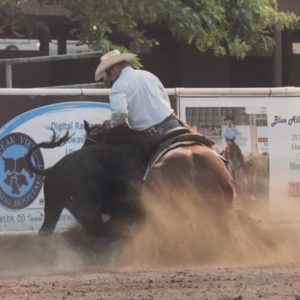
Clark and Lillys Vaquero
From showing paint horses as a kid in Kansas to starting colts and fixing rope horses in Colorado, Clark Weaver has been a life long student of the horse. He graduated from Colorado State University with an equine science degree. Weaver then moved to Amarillo, TX selling ads for AQHA. Weaver got involved in reined cow horse a few years out of college when he lived in Texas.
He later moved to Arizona where Al Dunning invited Weaver to ride with him. Weaver ended up buying a cutter. Weaver worked for many people, but was advised that he should ride the horses he wants to ride and be a non-pro, and that is the route he took.
Weaver said he has enjoyed learning all he can about the sport. It took some time to develop his professional career and be surrounded by the right people. Weaver said he treasures the little moments that add up to the big successes.
He remembers a Don Murphy clinic where he was asked if he could do a certain movement with his horse. Weaver couldn’t and realized that had been the problem all along.
“You work like crazy, and you get one piece of information that those guys have acquired and it fixes a series of things.”
“The first time I did really well in futurity finals was at the Derby in California. You can’t hear anything but when you’re going down the fence and you make this monster turn and all you hear is the guys that have been helping you screaming ‘feet, feet, feet’ and then it all comes together at the end… ”
He had a hard time when a bit judge told him he couldn’t use a specific bit. He vowed that he would learn to be a good winner and a good loser. He never made that mistake again, he said.
His goal is to win a major event like the Non-Pro Snaffle Bit Futurity.
“It’s the best group of horsemen. And they’re great horsemen because of who they are and how they approach being successful. There are other ways to make money in the equine space and this is a really hard one. It’s the people you get to hang around and the horses that have the desire to do this job to be able to go fast, to be able to slow down, they are so special.”
Why Clark Uses RCHTO:
“[I’m] looking for common threads in programs because I think a lot of fundamentals are the same. There’s 80-90% of [this] that everybody does, there’s a lot of different ways to get there. I think the trainers break down what they do and if you go get help, you’ll understand their vocabulary.
“I video myself when I have problems and put it next to the [trainers on RCHTO] and compare what mine look like versus theirs. I’ll watch something 100 times and get where their hand placements are, what they’re doing with their feet. A lot of times I’ll turn the sound off and watch what’s going on and then turn it back on. There’s so much information to gather from a 15 minute video that it take a couple dozen times to get things out of it…There’s the main thing they’re doing, but if you watch what they’re trying to do it relates to [other videos].”
